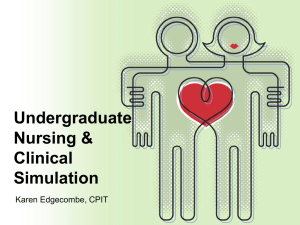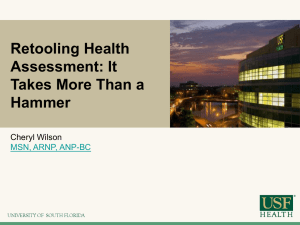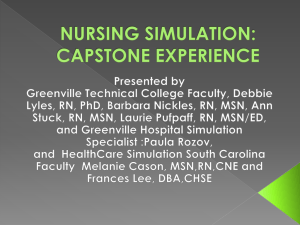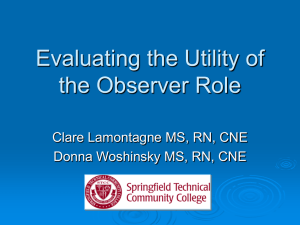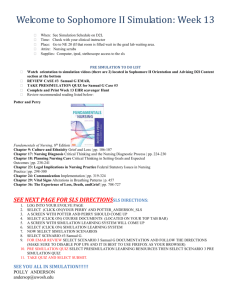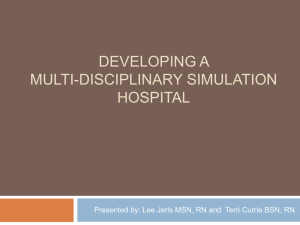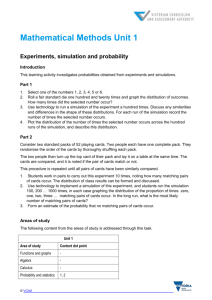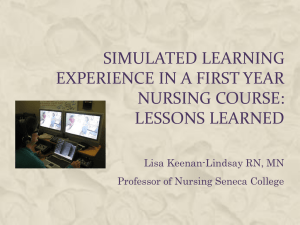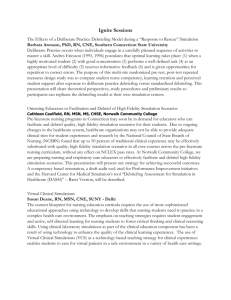Document
advertisement
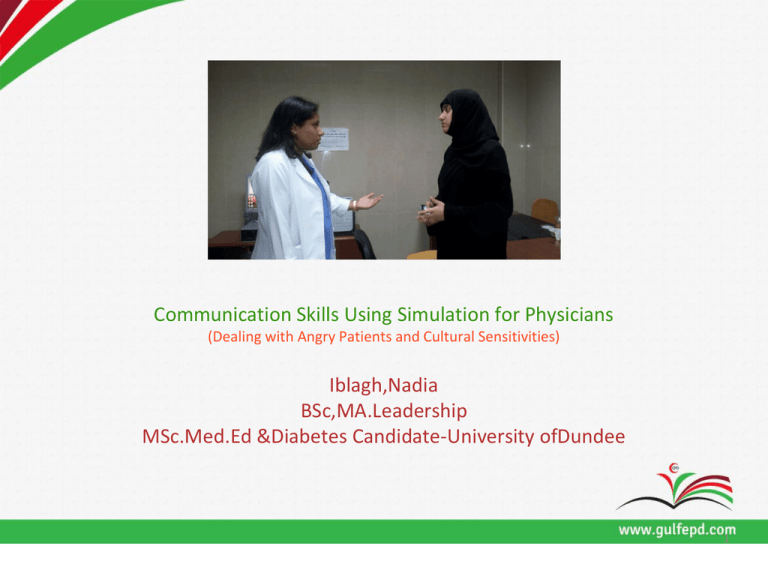
Communication Skills Using Simulation for Physicians (Dealing with Angry Patients and Cultural Sensitivities) Iblagh,Nadia BSc,MA.Leadership MSc.Med.Ed &Diabetes Candidate-University ofDundee 1 2 Introduction • Good non- technical (eg. vigilance, anticipation, clear communication, team coordination) can reduce the likelihood of error consequently of accidents. • Simulation is a powerful tool because it allows the trainer to systematically control the schedule prime, presentation of feedback and introduction( or suppression) of environmental distractions, within a safe, controlled environment. 3 Slide taken from Rhona flins ppt called “safety at the sharp End! 4 • Leadership • Team Work • Communication • Situation Awareness • Decision Making • Personal Limitations – managing stress and fatigue 5 • Reports of problems caused by miscommunication amongst Practitioners themselves Patients and the practitioners • Non- technical clinical skills vs Technical skills training in Kuwait 6 Objectives Designing a training session for HCP to train them on one NTS at a time . 7 Learning Outcomes 1. Identifying techniques for effective communication skills focus on dealing with angry patients 2. Being able to handle cultural issues effectively. 8 Methods • Standardized patients (SPs), a trained actor used as "real" simulators • The SP playing a specific role based on given scenario. 9 Teaching Strategies Number of strategies 1- SISFR 2- STEPS 10 1- SISFR • • • • • S = Set the context and identify roles and outcomes. I = Immerse in roles and practice for agreed time frame S = Summary presentation of progress with scenario F = Feedback from self, peers, and tutors R = Refine practice building on feedback. I 11 Feedback • Information describing students' performance in a given activity. • Key step in the acquisition of clinical skills. • Often omitted or handled improperly in a clinical training. 12 • When effective feedback is provided and focuses on directly observable skills and behaviors, important personal and educational progress can occur, Katz 13 Feedback & Debriefing Importance of the feedback & debriefing SETGO : • What student Saw. • What else the group/student Saw • What the student Thinks • What Goal do we want to achieve. • Any offers how we get there 14 The Intervention • • • Videotaping Setting the simulated scenario Immersion & belief 15 Evaluation & Feedback • • • • Comments on : the strategies used The reflection Authenticity Future trainings 16 Limitations 17 Notes Improved performance ? true progression ? or an artificial improvement!! 18 Conclusion/ Reflection • The results for this study would be used designing and providing non-technical skills session. offering practitioners, clinical skill sessions, using simulation equipped with standards teaching strategies to master those skills is a milestone towards a better health outcome. 19 References 20 1. Leonard M, Graham S, Bonacum D. The Human factor: the critical importance of effective teamwork and communication in providing safe care. Qual Saf Health Care 2004;13(Suppl 1):i85–90. 2. BeaubienJ,BakerP. The use of simulation fortraining teamwork skills in healthcare:how low can you go?QualSafHealthCare. 2004;13(Suppl ):i51–6. 3. MaguireP,PitceathlyC. Key communication skills and how to acquire them. BMJ.2002;325:697–700. 4. Johnston P, Fioratou E, Flin R. Non-technical skills in histopathology: Definition and discussion. Histopathology 2011; 59: 259– 367. 5. Flin R, OConnor P, Crichton. Safety at the Sharp End. A Guide to Non-Technical Skills. Aldershot: Ashgate; 2008. 6. Mitchel, A. M, Fioravanti M, Founds S, Hoffmann, R. L., & Libman, R. Using simulation to bridge communication and cultural barriers in health care encounters: Report of an international workshop. Clinical Simulation in Nursing, 2010; 6(5):193–198. 21 7. Fay-Hiller TM, Regan RV, Gordon MG. Communication and Patient Safety in Simulation for Mental Health Nursing Education. Issues in Mental Health Nursing 2012; 33(11):718-726. 8. KaufmanD.M.,ABC of learning and teaching in medicine: Applying educational henry in practice.BMJ(2003),326,213-216 9. JarcheH. Modelling,nots haping.[homepageontheInternet].2012[cited2012Nov 29]. Available from: http://www.jarche.com/2012/01/modelling-notshaping/ 22 10. Torre D.M., Daley B.J., Sebastian J.L., Elnicki D.M. Overview of Current Learning 11. Theories for Medical Educators. American Journal of Medicine 2006;119 (10):903-907. 12. Chronister C, Brown D. Comparison of Simulation Debriefing Methods. Clinical Simulation in Nursing, 2012; 8(7):281-288. 13. Pendleton D, Schofield T, Tate P., A method for giving feedback. In: The consultation: an approach to learning and teaching.Oxford: Oxford University Press, 1984. 68–71. 14. Carr S., The foundation program assessment tools: an opportunity to enhance 2006;82:576-9. 23 24 Thank You
